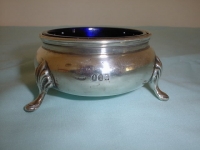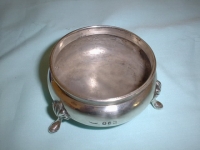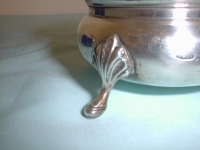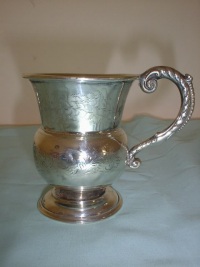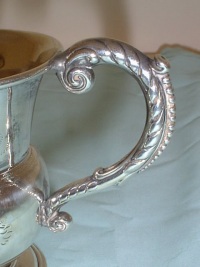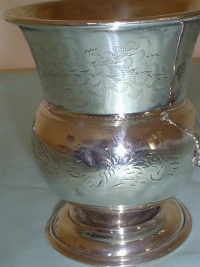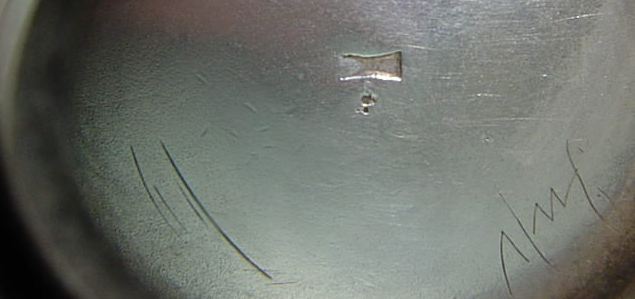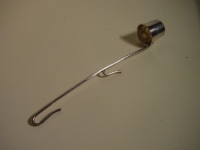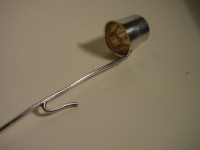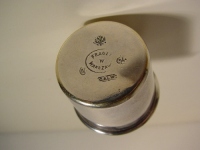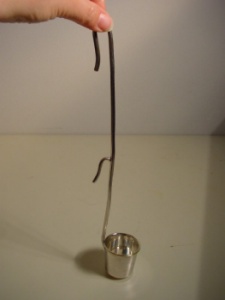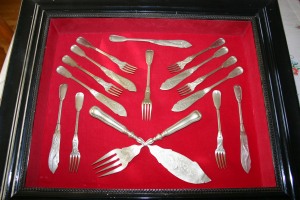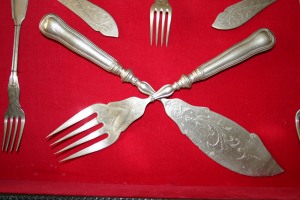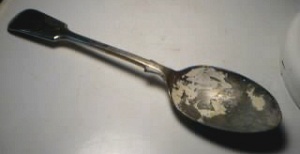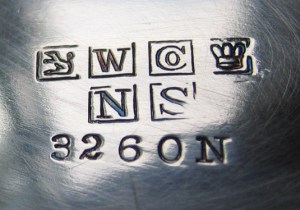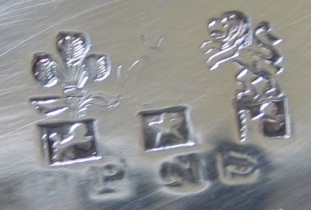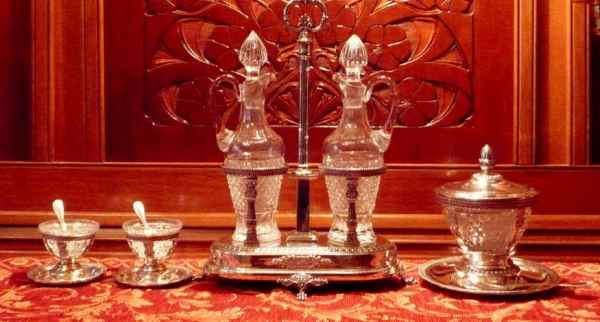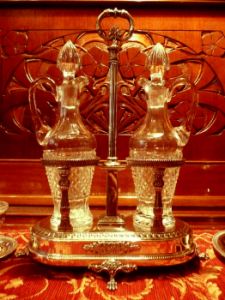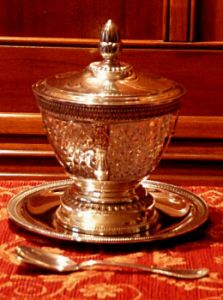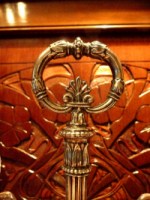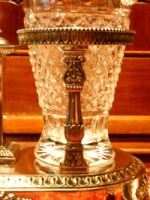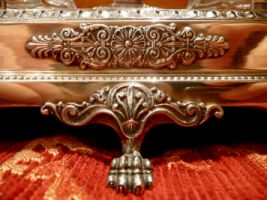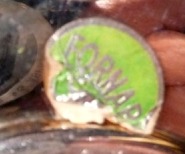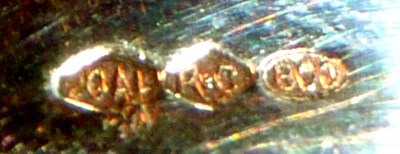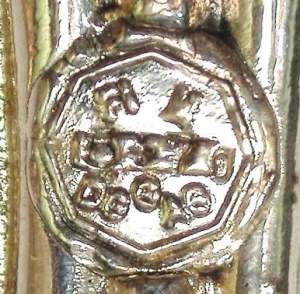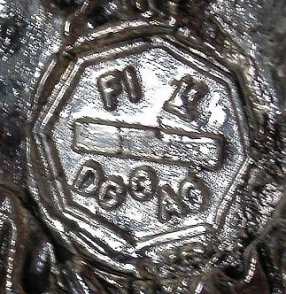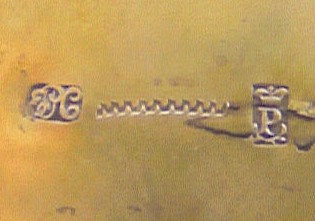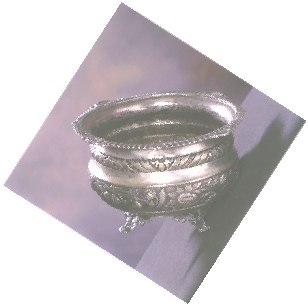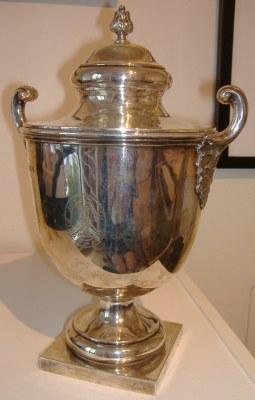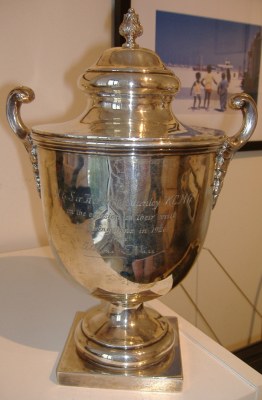 newsletter # 39 - JULY 2007
newsletter # 39 - JULY 2007www.ASCASonline.org
email: silverassociation@yahoo.it
YOUR GUIDE TO THE JULY NEWSLETTER:
articles new members
members' window
|
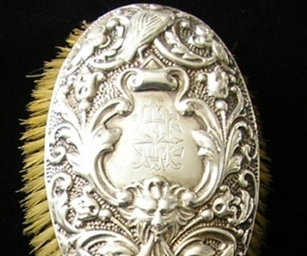 Sara L. Russell presents:
Sara L. Russell presents:The story of a well travelled hairbrush Once upon a time, Back in 1911 in fact, when the days of Art Nouveau were lazily drifting towards the more upbeat days of Art Deco... The brilliant silversmiths Levi and Salaman made a beautiful matching hairbrush and mirror set, in their workshops in Birmingham. Both hairbrush and mirror were made in a wonderful design, almost magical in fact.... click here |
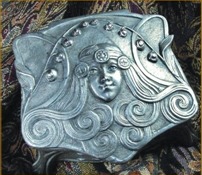 Joanne Wiertella presents:
Joanne Wiertella presents:The Language of Flowers Flowers have been greatly esteemed since the dawn of civilization. Ancient Egyptians painted them on their temple walls and the withered remains of flowers have been found in ancient tombs around the world. The colorful and fragile beauty of flowers has given rise to countless culturally symbolic meanings, and folktales about flowers have abounded from the earliest times --although not in the Western World until the end of the Middle Ages.... click here |
New members
Welcome to new ASCAS members:
Phyllis Argo - USA
Sharon Hoff - USA
Carolyn Ienna - Australia
Elizabeth Milkins - Australia
Massimiliano La Russa - Italy
Santiago Rodriguez Santafe - Austria
Emile Shalala - Lebanon
Steve Swan - England UK
Jack F. Wilson - USA
Members' Window # 39
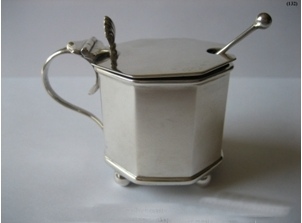
|
Mail to ASCAS: e-mail
silverassociation@yahoo.it
Ian Cook writes:
... I have attached some pictures of two pieces which I would
like help to identify.
The first is a Britannia Silver Salt, fairly large for its type
with a diameter of around 7cm and weighing 72g.
I have tried to date it but do not know how to read such
hallmarks. Slightly rubbed, I believe the maker to be H & O
perhaps you could enlighten me on its date and where it was
assayed.
The second piece is very unusual in shape, and the hallmark (near
the handle) is so rubbed even with a 30x loupe I can only make
out an anchor which is at an acute angle.
I was wondering if you could possibly put a date on it by the
design?
Very best regards
Ian Cook
Suzanne Meursinge writes:
.. I would like to ask you if you can help me to determine
the use of an object.
Do you know what this spoon is for?? It's nickel plate Norblin &
Co. Galw. Warszaw, Polish, Fraget.
Is it a snuffer? or for any drink, tea???
The measure is ca. 25,5 cm- ca. 10 inch.
I will be very thankful
Suzanne
John Shields writes:
.. I hope that you or someone in the group can help me.
Recently I was given this antique silverware set from my mom,
she had gotten it from her mother who had gotten it from her
aunt who was married to a gentleman who had fought in the civil
war. I have received some e-mails from other silverware sites
and they are telling me it is Fiddle Thread, can you please
help. Here is some of the info from the back of the handles.
Herrmann y Cia
Mexico
ALPACCA
Bob Kelly writes:
.. I have this spoon, it is in rough shape.
The marks are. Top of spoon, D&A, inside a crown kind of mark.
Running down the shaft of the spoon is A & N, each in a square
with round edges. CS in one oval, L in Square round edge. The
last mark is, AI or A1 in an oval.
That is all the marks I can see. Spoon is 8.75 inches long; bowl
3 ins long and 2 inches wide. Wide part of handle is 2 inches
long and 1 inch wide. The thin part of the handle is 2.75 inches
long and .25 inches wide.
This meets a slighter wide bit at the bowl. The spoon is very
thick.
Any information you can give me would be great.
Thank You in Advance.
Bob
Mike Stansbery writes:
.. I'm researching information on the hallmarks of a couple
silver items that I was unable to identify. I have taken the
liberty of attaching photos of the hallmarks, and I am hoping
you can tell me what they mean. I am NOT educated on silver,
though I know a lot more about it now that I have found your
site.
At any rate, the following hallmarks come from a silver creamer
(left) and from a silver sugar bowl (right).
Thank you in advance for whatever help you can give me
Sincerely,
Mike Stansbery
The maker of the sugar bowl (right) is E.G. Webster & Son
, New York .
I'm unable to identify the maker of the creamer and I trust on
ASCAS members help.
Giorgio Busetto
Alessandro Colemann writes:
.. I'm looking for information about a condiment set I
recently bought.
I believe it was made around 1950-1960 and, according to the
seller, the maker was the well known silversmith Fornari (see
http://www.fornari1905.com/about_fornari.php).
I'm not quite sure about this attribution as the piece bears
Fornari's label and a silver mark "AL20" unknown to me.
Any help would be greatly appreciated.
Alessandro Colemann
the mark AL20 refers to Ricci Argentieri Alessandria Spa -
C.so Acqui 219 - Alessandria (Italy) belonging to A. CESA & C.
Spa group (also "CESA 1882" belongs to this group).
Lozenge's mark was used in Italy between 1950/1970.
I believe that Fornari was only the retailer of your pieces
Giorgio Busetto
Fred Sinfield writes:
... Here is another example of "riempito" used for the grip
of a paper knife.
In article
The finial and shaft of a paper knife, 150mm long, is an example of this technique. Included in the capital is an octagonal seal with "Fl"? "DG e Ag", with the same seal on the shaft punched with "5÷7" and "?".
Stamped on the blade of the 40gram knife is the Florentine maker’s mark consisting of a pentangle, "1388" and "Fl" together with the silver standard of 925.
My question is: Who was the maker and when he was active?
Regards,
Fred
This piece was made after 1970 and before 1990, but,
unfortunately, I was unable to identify the maker
Giorgio Busetto
Martine D'Haeseleer writes:
... Does someone, in the group of silver' specialists, know
more about this object and marks?
The marks seem to be 19th Century - Portugal
Hallmarking, is 'probably' from Portugal, with the P for the
city of Porto.
Can one of you find more info about the city and period, I don't
have that book.
Thanks a lot
Martine
Philip Moore writes:
... Can you please give me some information on a fruit knife
I have found among my mothers effects?
It is 3" long when folded. The handle is mother of pearl. The
blade is stamped with a crow / lion / g which I think is
Sheffield 1924-5 Then it is stamped FH in a circle which ends in
an arrow head.
Any info you can supply would be gratefully received.
Thank you
Philip Moore
I believe that the maker is Francis Howard Ltd, 1900..1986 (entered
Apr 1901). Registered also in Glasgow and Edinburgh
I'm working on
www.silvercollection.it to a wide list, partly illustrated,
of makers' marks of England, Scotland and Ireland (about 3000
marks). I'll use your photo to illustrate this mark.
Giorgio Busetto
Replies to questions
Norma Young
sends an interesting addition to Malcolm Stander's
article
"HISTORY THROUGH SILVER TROWELS" in June
Newsletter:
Hello Mr. Busetto,
|
"A PAGE per MONTH"
In this column we present a page (one
page only) obtained from makers' brochures, books, auction
catalogs or whatever other printed paper, which may be of
particular interest for ASCAS members.
The images will be published at a "low resolution" level and for
private and personal use only
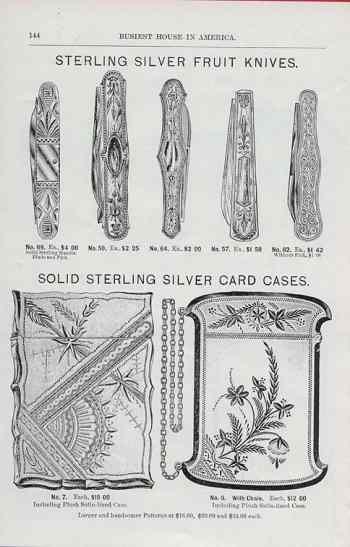
|
This month
ASCAS presents a page of " silver fruit knives and card
cases" from the "1889 ILLUSTRATED CATALOG"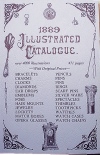
|
"A WORD per MONTH"
In this column we presents an abstract
from a page of the "What is? Silver Dictionary"
courtesy of
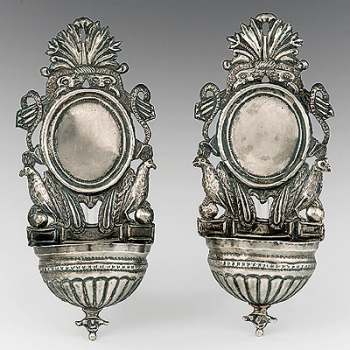
|
HOLY WATER FONTA holy water font is a vessel used for holding holy
water. They are sometimes imbedded in the walls, and
sometimes rest on a pedestal. The shell-shaped font
which has persisted was introduced in the 17th century.
The most ancient portable fonts for use in aspersions
were pails of lead or bronze covered with silver. The
present form of the aspersorium was introduced in the
13th century. The most ancient portable fonts are in the
form of pails and shaped like truncated cones. Those
most prized for their antiquity are of lead or bronze,
sometimes even of wood covered with a sheet of wrought
metal. However, if there ever existed ancient silver or
silver-gilt fonts, it is evident that they have not come
down to us.......
|
Closing our JULY 2007 edition of ASCAS Newsletter I hope you have appreciated its content.
Your comments, suggestions and advice will be of great help.
My thanks to Alessandro Colemann (Italy), Ian Cook (England), Martine D'Haeseleer (Spain), Jayne Dye (USA), Bob Kelly, Robert Massart (Belgium), Suzanne Meursinge (the Netherlands), Philip Moore (England), Sara L. Russell (UK), John Shields (USA), Fredric Sinfield (Australia), Mike Stansbery (USA), Joanne Wiertella (USA) Norma Young (Canada), for their invaluable contributions.
Giorgio Busetto
Secretary
ASCAS is a community of people having a common
interest in antique silver.
|

